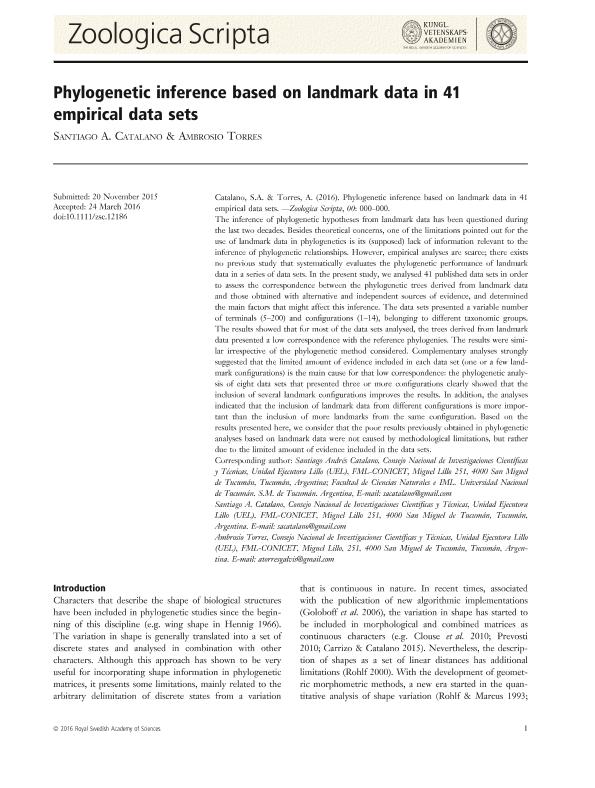Mostrar el registro sencillo del ítem
dc.contributor.author
Catalano, Santiago Andres

dc.contributor.author
Torres Galvis, Ambrosio

dc.date.available
2018-08-22T18:30:38Z
dc.date.issued
2017-01
dc.identifier.citation
Catalano, Santiago Andres; Torres Galvis, Ambrosio; Phylogenetic inference based on landmark data in 41 empirical data sets; Wiley Blackwell Publishing, Inc; Zoologica Scripta; 46; 1; 1-2017; 1-11
dc.identifier.issn
0300-3256
dc.identifier.uri
http://hdl.handle.net/11336/56630
dc.description.abstract
The inference of phylogenetic hypotheses from landmark data has been questioned during the last two decades. Besides theoretical concerns, one of the limitations pointed out for the use of landmark data in phylogenetics is its (supposed) lack of information relevant to the inference of phylogenetic relationships. However, empirical analyses are scarce; there exists no previous study that systematically evaluates the phylogenetic performance of landmark data in a series of data sets. In the present study, we analysed 41 published data sets in order to assess the correspondence between the phylogenetic trees derived from landmark data and those obtained with alternative and independent sources of evidence, and determined the main factors that might affect this inference. The data sets presented a variable number of terminals (5–200) and configurations (1–14), belonging to different taxonomic groups. The results showed that for most of the data sets analysed, the trees derived from landmark data presented a low correspondence with the reference phylogenies. The results were similar irrespective of the phylogenetic method considered. Complementary analyses strongly suggested that the limited amount of evidence included in each data set (one or a few landmark configurations) is the main cause for that low correspondence: the phylogenetic analysis of eight data sets that presented three or more configurations clearly showed that the inclusion of several landmark configurations improves the results. In addition, the analyses indicated that the inclusion of landmark data from different configurations is more important than the inclusion of more landmarks from the same configuration. Based on the results presented here, we consider that the poor results previously obtained in phylogenetic analyses based on landmark data were not caused by methodological limitations, but rather due to the limited amount of evidence included in the data sets.
dc.format
application/pdf
dc.language.iso
eng
dc.publisher
Wiley Blackwell Publishing, Inc

dc.rights
info:eu-repo/semantics/openAccess
dc.rights.uri
https://creativecommons.org/licenses/by-nc-sa/2.5/ar/
dc.subject
Landmarks
dc.subject
Phylogeny
dc.subject
Morphology
dc.subject.classification
Otras Ciencias Biológicas

dc.subject.classification
Ciencias Biológicas

dc.subject.classification
CIENCIAS NATURALES Y EXACTAS

dc.title
Phylogenetic inference based on landmark data in 41 empirical data sets
dc.type
info:eu-repo/semantics/article
dc.type
info:ar-repo/semantics/artículo
dc.type
info:eu-repo/semantics/publishedVersion
dc.date.updated
2018-08-17T16:56:34Z
dc.journal.volume
46
dc.journal.number
1
dc.journal.pagination
1-11
dc.journal.pais
Reino Unido

dc.journal.ciudad
Londres
dc.description.fil
Fil: Catalano, Santiago Andres. Consejo Nacional de Investigaciones Científicas y Técnicas. Centro Científico Tecnológico - Tucumán. Unidad Ejecutora Lillo; Argentina
dc.description.fil
Fil: Torres Galvis, Ambrosio. Consejo Nacional de Investigaciones Científicas y Técnicas. Centro Científico Tecnológico - Tucumán. Unidad Ejecutora Lillo; Argentina
dc.journal.title
Zoologica Scripta

dc.relation.alternativeid
info:eu-repo/semantics/altIdentifier/doi/https://dx.doi.org/10.1111/zsc.12186
dc.relation.alternativeid
info:eu-repo/semantics/altIdentifier/url/https://onlinelibrary.wiley.com/doi/abs/10.1111/zsc.12186
Archivos asociados
